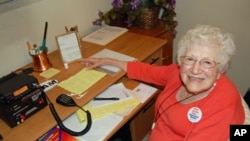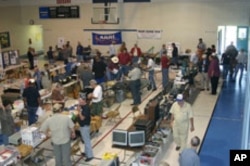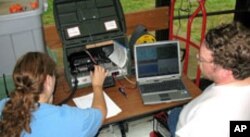With millions of people posting up-to-the-minute photos on Facebook, checking Twitter and snuggling up to iPhones, it's easier than ever to stay in touch.
So you might expect those two-way radios to have gone the way of rotary phones by now. A few years ago, several blogs even put ham radio alongside 35 millimeter film and VHS video tape on a list of once popular things slated to disappear. But they were wrong.
In fact, the hobby where you can make your own antennas to send and receive signals and tap out messages in Morse code is thriving.
Ham radio resurgence
New hams like Helen Schlarman are part of an upswing in the hobby.
Sitting in a spare bedroom with a compact, two-way radio before her, she pushes the talk button, announces her personal call sign, and looks up a friend across town. He answers and they start a conversation about everyday things, such as why his dog is at the window, barking.
Many hams chat with friends around the world and hang postcards from their global contacts on their walls, the way hunters might show off antlers from deer they've shot.
Helen Schlarman's chats are mostly local and that's fine with her. She's 89 and loves amateur radio's camaraderie.
"It's a different community. There is no stereotypes of age. It's just talking and sharing and enjoying," she says, adding that the hobby is perfect for an outgoing person who stays inside a lot.
Making it easier
Until recently, ham radio was declining from its peak in 2002 as older operators died.
But three years ago, the government phased out the Morse code test that many saw as a stumbling block to getting a license. Maria Somma, of the American Radio Relay League, says that change sparked a lot of interest.
She notes that last year, the Federal Communications Commission issued a near-record number of licenses. "We had over 30,000 new amateurs coming in to the radio service, and the trend seems to be going upward." Today, about 700,000 Americans have ham licenses, a nearly 60 percent jump over a generation ago.
Allen Weiner, who follows technology trends at Gartner Research, does not find those numbers all that surprising.
Unique experience
While it will never have the high-tech cachet of the iPhone, Weiner says ham radio has a certain 'nerd appeal.' "If it creates its own experience, that's really what's key here. If it just emulates an experience that you can get online, it's not going to grow."
At a ham radio convention near St. Louis, the crowd swapping antenna parts and other equipment is mostly male and over 50.
But the hobby has also attracted 15-year-old Jonathan Dunn. He says Facebook and texting are fun, but making friends using a simple two-way radio is more rewarding.
"With ham radio you can talk to new people, all kinds of ages, races, and it's just amazing what a little radio can do," he says. "Because no matter where you're at, if you have the right stuff and the right power, you can talk to anyone."
Even though amateur radio is often more about the medium than the message, Jonathan's father Steve Dunn observes that all that polite chit-chat over the airwaves is still important, especially for a teenager. "If young people have the opportunity to communicate with a wide range of people, that instills a certain amount of confidence in their ability to carry on the lost art of small talk."
Hobby with a higher calling
But ham radio isn't just about casual conversation.
Even with all of today's digital technology, there is still a need for people to talk over long distances, without the help of wires or cell phone towers.
Many hams are trained to provide emergency communications during a disaster. That proved valuable after the earthquakes in Haiti and Chile, when many mobile phones and land lines failed.
Still, even the most die-hard hams concede theirs will never be a mainstream hobby.
After all, being an amateur radio operator takes skill and technical knowledge, and will never match the ease and convenience of smart phones and the Internet. But even so, there are those who still find great joy in communicating with friends near and far via 20th century technology.











